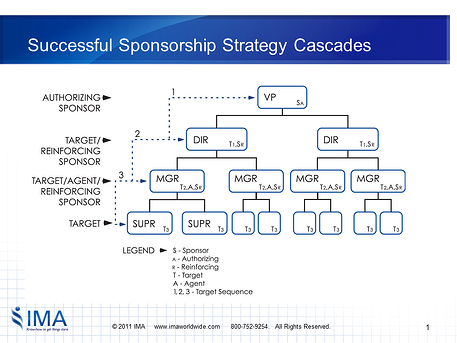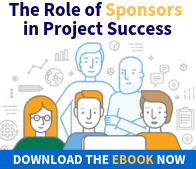If you are a Change Agent assigned to a project, do you know who all your Sponsors are? It's a critically important question, and the answer is not necessarily obvious. In fact, one of the biggest "aha's" from our AIM change management training is that there are far more Sponsors that need to be attended to than what Change Agents originally thought! 
Sure, you may have one or more Executive Sponsors who have responsibility for assigning resources and funding for the project. But project Sponsorship doesn't end with these individuals!
Too often, Change Agents spend the bulk of their energy and time focused on trying to create what we call "enthusiastic Targets" without understanding that there are many leaders who have far more impact on the success of the project! No Target is more important than these Sponsors who must provide demonstrated commitment.
That's why we follow a rigorous process for identifying all the Sponsors for a project and produce a deliverable called a Key Role Map.
Identifying Your Sponsors
The Key Role Map provides a graphic depiction of all your Sponsors based on identifying all the Target groups that are impacted by your change. If you think you know who all those Target groups are already, we can almost guarantee that you are missing some groups unless you have completed a Key Role Map!
 "Those impacted" include any resources you have working on the project, and all the support services that are involved in some way in your change. So, for example, if the IT organization and/or the Training organization are providing support services, they need to be included in your Key Role Map. Each and every resource must be Sponsored!
"Those impacted" include any resources you have working on the project, and all the support services that are involved in some way in your change. So, for example, if the IT organization and/or the Training organization are providing support services, they need to be included in your Key Role Map. Each and every resource must be Sponsored!
The Key Role Map also depicts the actual implementation roll-out.
There are some other fundamental "implementation" best practices that are reflected in the Key Role Map. Here are a few examples:
- There are two types of Sponsors. The Authorizing Sponsor legitimizes the change and provides the required resources. The Reinforcing Sponsor demonstrates commitment through his/her personal action with those direct reports who are impacted by the change.
- Every Sponsor (Authorizing and Reinforcing) and Agent must be considered a "Target" first. Their ability to serve as a Sponsor or a Change Agent is only possible when that individual has moved past being a Target themselves. For this reason, all Sponsors and Agents are coded as Targets first on the Key Role Map.
- An Authorizing Sponsor can't report to a Reinforcing Sponsor, or to another Authorizing Sponsor.
- Ultimately, every Reinforcing Sponsor must report either directly or through the chain of command of Reinforcing Sponsors to an Authorizing Sponsor.
As you are thinking, there are way more Sponsors for your project than just one or two "Executive Sponsors" or even an "Executive Steering Committee."
This is why securing project Sponsorship is complicated, labor-intensive, and the most important activity of any Change Agent. When Change Agents "miss" identifying all their project Sponsors, the implementation is at risk!
Stakeholder Analysis is Insufficient
Once you have completed a Key Role Map for your project you will see the limitations of the traditional change management Stakeholder Analysis. The Stakeholder Analysis doesn't help to sequence a change and there are no specific responsibilities of "Stakeholders." The typical analysis is broad and doesn't depict a sequenced rollout.
The Key Role Map is a dynamic document. It's constantly changing because the organization is constantly changing. It needs to maintained and updated through the entire project lifecyle.
Once you have mastered Key Role Mapping, you will see that it is arguably the most important resource for any Change Agent or project team.


